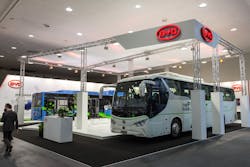BYD Launches Zero Emission Partnership with Los Olivos Elementary School District
China’s largest electric vehicle maker BYD is partnering with the Los Olivos Elementary School District, will bring a BYD Type A electric school bus, “The Achiever” to students in Santa Barbara County and create the first U.S. school district to have a 100% zero-emission fleet of school buses.
Members of the Sheet Metal, Air, Rail and Transportation (SMART) workers Union, Local 105, will perform final assembly on the bus at BYD’s manufacturing facility in Lancaster, California.
“Since we began this process, our goal was to be the first school district in the Santa Ynez Valley to have a fleet that could serve our students and our community, and through this partnership we have accomplished just that,” said Ray Vazquez, Superintendent/Principal of Los Olivos Elementary. “Our electric bus will provide cleaner transportation and benefit our community by decreasing our carbon footprint. On behalf of the Los Olivos school district and the community, we are thrilled to partner with BYD.”
ChargePoint, an electric vehicle charging network, will provide charging infrastructure to Los Olivos School District for the Type A school bus.





